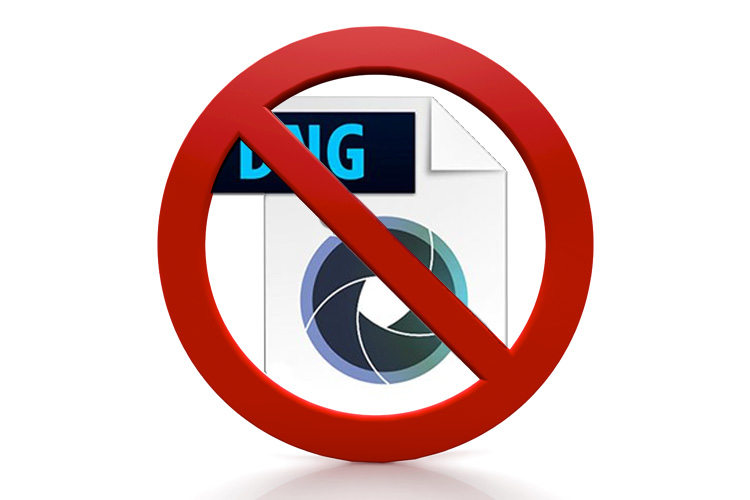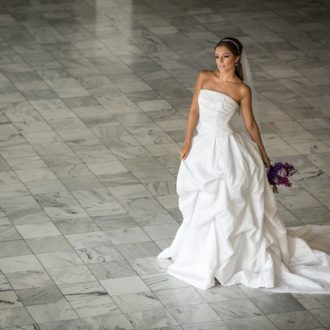Why I Don’t Convert My RAW Images to DNG

Hi, gang and Happy Friday! I’m going to try and keep this as short and sweet as possible, but it’s important to note up front — I’m not telling you-you shouldn’t be converting your RAW files to the DNG format — I’m just telling you I’m not, and I stopped doing it a while back. Here’s why:
Converting to DNG in Lightroom takes time, I don’t get much benefit back from taking that extra time and so for me and my workflow, it just doesn’t make sense.
None of the big three camera makers adopted the .DNG format
Only a handful of smaller companies did, so it never really caught on like it would have if they had all gotten on board. I don’t share files with other users where I need to keep my RAW edits intact when sharing the original RAW file with another user (see this article), so combining the .XMP file and the RAW original into one single file isn’t a benefit to me (I don’t work with XMP files that often to begin with). Plus, if I did convert to DNG for that reason, it takes longer to re-save the entire DNG file over again each time you make a change than it is to just save changes to a .xmp text file, which happens very quickly in comparison. It’s that wasting time thing again.
Am I concerned that one day I won’t be able to open my existing native RAW files created by the camera companies?
Not at all. At the time Adobe created the DNG spec, it was probably a legit concern, but these days a 12-year-old could probably write a RAW converter during study hall, so I don’t sweat it.
I know there are a handful of other pros of using DNG, but there are just as many cons. Maybe more.
I’m happy with where I’m at — working faster, not wasting time on import converting to DNG, and I still sleep well at night. Something to think about, anyway. 🙂
Hope you have a great weekend, and we’ll catch you next week.
Best,
-Scott
P.S. Just 12-days until the annual Photoshop World Conference in Orlando. People are signing up every day (a bunch signed up just this week). You can still sign up and join in. Detail/Tickets right here. Hope you can make it.



I am running old software and my software only recognizes my .DNG files. If I was running the latest stuff I wouldn’t bother converting it. But it’s sort of a choice between old software that I own for my lifetime or paying a monthly fee for the new software.
[…] It is a file format — truly a open-source RAW picture format created by Adobe. The file extension is .dng (quite than the proprietary ones from Canon (like .CR2 or .CR3(, or Nikon Uncooked information (.NEF), or Sony’s (.ARW information). For extra on my ideas on DNG, click here. […]
[…] It is a file format — really a open-source RAW picture format created by Adobe. The file extension is .dng (fairly than the proprietary ones from Canon (like .CR2 or .CR3(, or Nikon Uncooked recordsdata (.NEF), or Sony’s (.ARW recordsdata). For extra on my ideas on DNG, click here. […]
[…] It is a file format — truly a open-source RAW picture format created by Adobe. The file extension is .dng (relatively than the proprietary ones from Canon (like .CR2 or .CR3(, or Nikon Uncooked recordsdata (.NEF), or Sony’s (.ARW recordsdata). For extra on my ideas on DNG, click here. […]
[…] This is a file format — actually a open-source RAW image format created by Adobe. The file extension is .dng (rather than the proprietary ones from Canon (like .CR2 or .CR3(, or Nikon Raw files (.NEF), or Sony’s (.ARW files). For more on my thoughts on DNG, click here. […]
Lightroom’s “Do not import suspected duplicates’ doesn’t recognize the RAW files as duplicates, even if it did the conversion on import.
What I found out a couple of times, when you bye a brand new camera and your software doesn’t recognize the RAW-files, after converting (with the newest Camera Raw convertor) the software still doesn’t recognize the DNG-files. I think that’s because there are new functions in the RAW-file, from which the software has no idea… Those functions are flawlessly converted to DNG, but then still your software has no idea… Converting to DNG when buying a (too) new camera for your editing software? It never worked for me…
I teach Lightroom and few years ago, I put together my own David Letterman style of “The Top Ten Reason Not to Convert Your Images to DNG Files”
1. Precludes you from using OEM software You will never be able to use your camera manufacture’s software again. Ever. Features that are specific to certain cameras (like Nikon’s Active D-Lighting and Picture Control) are not supported in the DNG format. Do you really think that Adobe knows everything that’s in every proprietary RAW file format it supports?
2. Backing up images will take longer In Lightroom, many of the changes you make can be stored in small XMP sidecar files that accompany raw files, and are only a few kilobytes. When you convert to DNG, changes are made directly to the file, so when you back up your images (hopefully daily) the whole file, typically 20 MB or more, needs to be backed up instead of just the small XMP sidecar files.
3. Metadata can’t be read by other software XMP data, including keywords, stars, and metadata that you may have changed in Lightroom is not available if you want to use another program that can read XMP sidecar files but not DNG files.
4. Longer downloading times from your memory card If you convert images to DNG upon importing to Lightroom, processing times increase since Lightroom must import and convert all the files to DNG.
5. File sizes One argument is that DNG file sizes are more efficient and can be up to 20% smaller. In 1956, the first IBM Model 350 hard drive weighed over a ton, cost $329,928 (in 2014 dollars) annually to lease, and stored 3.75 MB of data. It would have taken over 20 of them to hold a single Nikon D810 (36 MP) 14-bit RAW image file. Today, a 3 TB hard drive (formatted) holds the equivalent of 725,333 of the Model 350 hard drive and costs $100. The equivalent storage capacity, using the IBM Model 350 hard drive, would cost $14.9 billion to lease the same capacity (not to mention the 11.6 million square feet to store them, or the cost of electricity to run them. I’m not concerned about the size of native RAW files!
6. Load times DNG files supposedly load faster in the Develop module. With faster processors and Smart Previews, RAW files load very quickly in the Develop module even from an external drive USB 3.0 drive.
7. Ability to read RAW file in the future. One of the other main arguments in favor of converting to DNG files is that if a camera manufacturer stops producing software that can read their RAW files, then their RAW files would be unreadable. I don’t think Nikon, Canon, or Sony are going away anytime soon, and even if they were, you could use their software to read their files. Worst case, you could always convert them to DNG.
8. DNG is not an industry standard, it’s Adobe’s standard. As much as Adobe would love the DNG format to become the industry standard, it’s not. It’s Adobe’s standard. While a few camera manufactures produce camera the shoot DNG file as their native RAW files, most do not. DNG requires a lifelong allegiance to Adobe.
9. Camera brand not easily identified. Converting all your files to DNG makes it harder to quickly identify the camera manufacturer when looking at the file name since the suffix will be a generic DNG, and not one associated with your camera.
10. No obvious benefit. For all the reasons touting the DNG format, perhaps the biggest reason not to convert is that there is no obvious benefit. DNG files don’t contain more information (maybe less), are negligibly smaller, don’t load appreciably faster, take longer to download because the must be converted, and ties you to Adobe forever! They simply are, understandably, a greater benefit to Adobe than you, and have not been embraced as a standard format.
Is there any path to convert a DNG file back to native raw?
No, there is no way back from a straight DNG conversion. There is an option to embed the original raw in the DNG when you first convert (only after import or using the DNG converter), but this dramatically increases the file size and undermines one of the benefits of DNG (smaller file size), so it is not often used.
How do you crack the RAW out of such a DNG if you need it ?
With the Adobe DNG converter. https://helpx.adobe.com/photoshop/using/adobe-dng-converter.html
I own an Olympus and had all sorts of difficulties until I converted to DNG.
How do I stop Lightroom from converting to dng?
It’s an option at the top of the “Import” dialog panel, you’d just choose “Copy” “Move” or “Add” – they do what they describe to your source files without making a DNG conversion… I copy off the card to a drive folder outside of LR, then choose that folder in the import dialog and choose “Add” .
I keep in native raw (NEF) because I can then use different raw converters. Converting to DNG locks you into the Adobe world. F**k that.
I need a very compelling reason to throw away data. DNG isn’t it.
What convinced me to stop was the simple fact you can’t convert back from DNG to the native raw file. I would probably go back to converting if it was possible to round trip, but it’s a one-way street.
I shoot Pentax so it comes in DNG strait out of camera. 😉
Hey, at least you don’t have to wait for the conversion, right? 🙂
It’s funny, I’m importing 998 files from a wedding I just shot into Lightroom right now thinking I need to speed up this workflow, while I was waiting I jumped onto Facebook and this article popped up.
As I still have time, plenty of time, before the conversions finish I had a look to see how much space I’m saving, across the board I’m saving about 13% on disk space by converting to DNG, that is about 68,000 RAW files versus about 78,400 DNG files – 10,400 extra images per 2TB HD. This translates to roughly 10 weddings.
This means the savings on external hard drive is roughly NZ$16.77, however, the actual hourly cost of my time is NZ$57.76 as a wedding photographer – keeping in mind this is the average amount I earn per wedding per hour regardless if I’m shooting or editing.
What this means is by saving NZ$16.77 in disk space I’m costing myself NZ$57.76 in time on every wedding shoot! Over a year this equates to over $2,000 in time.
I have come to the conclusion that I need to stop converting to DNG!!!
Thanks for that Scott
Wow! Thats the most compelling argument to stop right now!
If you needed/wanted DNG for some reason, just convert after import and don’t waste the time during import. At a moment of convenience (long) after import is over, select the photos in Grid view and go to Library > Convert photos to DNG, then walk away, go to bed, make a sandwich, and let it run.
I think the original worry was that Adobe or someone else would eventually drop support for very old cameras. As far as I know, that has never happened and Lr is able to read RAW files from every camera ever made. I don’t see that changing (the code is minuscule as a look at an open source raw converter will show).
I could have sworn that at one time you were recommending that people convert to DNG.
There was a time, but as mentioned in the article above, I stopped converting years ago.
Is that about the same time your Canon sponsoring started?
i get better results from dng in LR with nikon!!?! its a better kin of noise clearer picture. the nois looks like the fine korn of noise in fuji cams. stange
crazy spelling..sorry;)
Indeed – I remember it well. I also recommended people do so based on Scott’s strong argument at the time to do so. Technology moves on I guess!
Really, show me that 12 year old…..
I have an article in the next Lightroom magazine on the topic of DNG (inspired by your nudging), and I’m pretty much in line with your thinking except there is one time where I do convert.
I just want to point out the reason I DO use DNG files. It’s the checksum. If I need to validate that my files have not changed, I can verify the contents using the checksum.
How would the contents change? Corrupt hard drive, bitrot, and any kind of data recovery.
Just my two cents.
Can’t you just run an md5 checksum on a raw file?
Yes, but the raw won’t have it inside of it to compare against. The DNG will…
In the past I’ve had trouble with old DNG files from Lightroom imported into Capture One and taken back into Lightroom. That’s why I stopped, tho I’ll sometimes send DNGs back from C1 to Lightroom, eg select from NEFs in Lightroom, then NEF to C1, then DNG to Lightroom (via a buffer file). After further edits in LR I convert the massive DNG to JPG and delete the DNG, leaving the NEF and a jpg.
This palaver is all motivated by a preference for the C1 RAW engine as a starting point, tho LR is now as powerful as I need for editing.